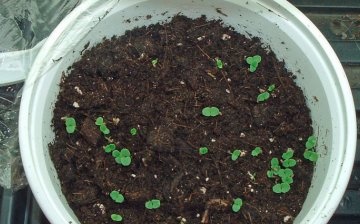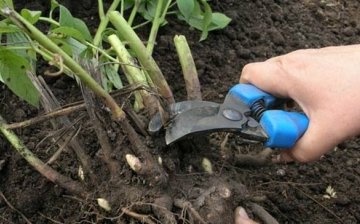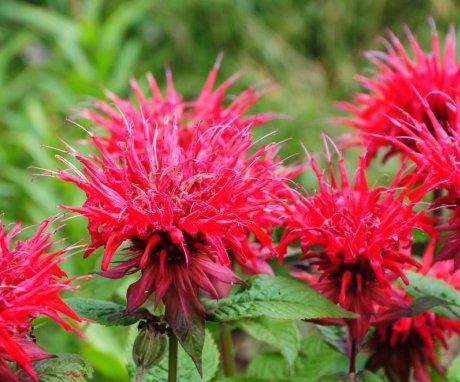Chervona rue flower: all about growing
Chervona (red) rue is a plant of the Yaroslavl family. Its scientific name is double monard. The plant is grown in flower beds, in the garden. Dry leaves are thrown into tea for a pleasant aroma. Monarda raw materials are used in folk and official medicine.
Content:
- Types of rue
- Double monard and its description
- Seed propagation
- Reproduction by dividing the bush
- Growing red rue
- The use of the plant in medicine
Types of rue
Chervona, (red) rue was heard in the 70s of the last century thanks to the song of Vladimir Ivasyuk, performed by Sofia Rotaru. It seemed that this is a flower of unusual beauty, because it is able to bewitch a loved one.
Everything turned out to be more prosaic. The name itself comes from the Mediterranean plant ruta (fragrant rue), which was more used as a medicine and a spice. But her flowers are yellow. There is no consensus on which flower to call a rue rue.
This is how several plants are called rue in Dahl's dictionary:
- Wild rue (common harmala).
- Ruta stone (venus hair).
- Ruta meadow (yellow basil).
There is also a fragrant rue (golden, garden). In the Carpathians, where the famous song came from and on the slopes of which a magic flower was supposed to grow, the evergreen flowering plant, the myrtle rhododendron, is called the rue.
Double monard and its description
Now the flower of the rue is called the double monarda. His homeland is North America. It is an aromatic medicinal plant of the labiate family. The height of its shoots reaches 0.7-1.5 m. The rhizome grows horizontally. Stems are tetrahedral, erect, leafy. The coarsely toothed leaves are slightly similar to nettle and lemon balm, covered with small villi from below. If you rub them with your hands, a pleasant aroma is felt. Leaf color is light green, veins are reddish. Length from 6 to 15 cm.
Flowers are small, up to 4 cm long, two-lipped. They are collected in a dense, capitate inflorescence, with approximately 30 flowers each. The stipules are large, often the same color as the petals.
Monarda flowers can be in color:
- Red
- Pink
- White
- Purple
Hybrid species with double flowers have been created. Varieties:
- Cambridge Scarlet with bright crimson flowers, 6 cm inflorescences.
- Rose Queen is pink.
- Prarie Nacht in deep purple flowers.
- Sunset with purple flowers.
A fruit is formed in the place of the flower. When dry, it breaks down into 4 nuts. Small seeds are suitable for sowing for 3 years. All parts of the plant contain a lot of essential oils. They give a pleasant aroma, for which the rue is called lemon mint. Many people find the scent similar to bergamot.
Seed propagation
Propagate monarda seeds, planting them on seedlings or sowing directly into the ground. When propagated by seeds, the characteristics of the variety are not transmitted, but a new variety can be obtained.
Seeds need stratificationgerminate slowly. In the southern regions, they are sown immediately after ripening or in February, when the snow comes off the site. So that small seeds are not sown in a heap, mix them with sand. The soil is slightly loosened, after adding sand. Close up no deeper than 2 cm.
More often, red rue from seeds is grown in seedlings:
- They are sown in boxes for seedlings in January or February.
- Scattered over the surface or embedded in a few millimeters.
- Pour gently from a spray bottle.
- Cover with glass or foil, set in a warm place (20 ° C).
- When the seedlings hatch, they are transferred to a brighter place and the air temperature is lowered. This happens 3 weeks after sowing.
- After another 3 weeks the plants dive in separate cups or containers so that the distance between the plants is at least 3 cm. At the same time, the tip of the root is cut off, which will cause active growth of the root system and accelerate flowering.
- In May, seedlings are planted in open soil. By this time, she should have formed 3 pairs of real sheets.
The site is prepared in advance. They bring in 3 kg of humus and peat per square meter of area. If the soil is acidic, lime it by adding 40 g of slaked lime. Add mineral fertilizers: 20 g of potassium salt, 40 g of superphosphate. Dig up the site, remove the weeds.
When the time comes to transplant the seedlings into the soil, add 20 g of ammonium nitrate per square meter of area and loosen it to a depth of 15 cm.
The distance between the bushes is not less than 60 cm. The transplanted plants are abundantly watered and mulched. This will help retain moisture in the soil. Seedlings tolerate frosts down to -5 ° C. The bushes will bloom next year. The first flowers on the strongest bushes may appear in the year of planting.
Reproduction by dividing the bush
Hybrid varieties of red rue are propagated only dividing the bush or green cuttings. The bushes of monarda double grow rapidly. This allows you to obtain a large amount of material for propagation. The bushes are dug out completely or a part of them is cut off with a sharp shovel. With this method, there is a risk of damage to the wound surface with fungal diseases.
It is advisable to treat the cut site with crushed charcoal or other disinfectants.
The dug bush is freed from the old earth. For this, you can use running water. Cut into small parts, disinfect the cut sites. They are planted in separate holes in the same way as seedlings.
If it is not possible to get part of the bush with roots, you can propagate the monarda cuttings... They are harvested before the flowering period. Tear off all the leaves from the bottom, and cut off the top ones partially. Cuttings are installed in washed sand, covered with a greenhouse (a jar cut with a plastic bottle). Set in a warm, dark place. In 3 weeks, the cuttings will have roots. They continue to care by watering the plants. Planted in September.
Growing red rue
Shoots of rue rue hatch from the melted earth immediately after the snow melts. The first flowers begin to open in July. Flowering continues until the end of August. A large three-year-old and older bush has up to 40 shoots, on which there are about 200 flowers. It remains decorative until November. At this time, few flowering plants remain in the garden, so the flower is appreciated by gardeners.
Ruta prefers a slightly acidic, light soil, but it grows well on black soil.
It must be drained so that moisture does not stagnate near the roots. In the wild, the monard grows on wastelands and along roads. Therefore, a sunny and dry place is chosen for it. In the shade, the bush grows well, but blooms poorly. It is advisable to plant in an area where there are no drafts.
Monarda does not require special care during the growth process:
- Weed the aisles, loosen the soil to improve the flow of air to the roots of the plant.
- Watering is necessary only in case of severe drought.
- For abundant flowering, it needs feeding. As a fertilizer in the spring, a mixture of rotted manure and peat is used; in the summer, every 2 weeks is applied Kemiru or Agricola from mid-May to early September. Grows well after feeding with infusion mulleindiluted 1:10.
- The plant is practically not damaged by diseases and pests. Insects are repelled by a strong odor, phytoncides also protect against diseases. Sometimes the monard is amazed powdery mildew... You can get rid of the disease by treating the plant with copper-containing preparations.
Chervona Ruta is a frost-resistant plant. She does not need to be covered for the winter. The aboveground part dies off, and the roots remain intact.
The use of the plant in medicine
Due to the large amount of essential oils, iodine monarda is used as an antiseptic and antibacterial agent:
- From the leaves of the rue, infusions are prepared that improve the functioning of the digestive tract. An oil infusion of rue, prepared in a ratio of 1:10, helps well against colds. Heat for 2 hours in a water bath, cool, filter.
- An alcoholic solution of leaves and stems is used to wipe the skin for fungal infections and abscesses on the skin. Alcohol solution helps to heal wounds, rinse the throat with tincture. If there is no ready-made medicine, and the cut needs to be urgently treated, the leaves of the monarda are crushed and applied to the wound.
- From the leaves of monarda, teas are prepared that relieve headaches, lower temperatures, and increase immunity.
- Ruta leaves help treat stomatitis, relieve toothache. Thymol, which is found in the leaves and flowers of red rue, is used to make mouthwash.
- Tea made from monarda leaves improves sleep, calms the nervous system.
By its taste, it resembles the famous Earl Gray tea. The Indians called the monardu tea Oswego in honor of the lake of the same name, on the shore of which the plant was often found.
More information can be found in the video:























ABOUT! And we do not have this in the country. Strange ... I think I'll go for seeds just tomorrow, I will definitely buy a bag for the flower bed. It looks very nice and blooms for a long time. It will just be) Thank you for this material!